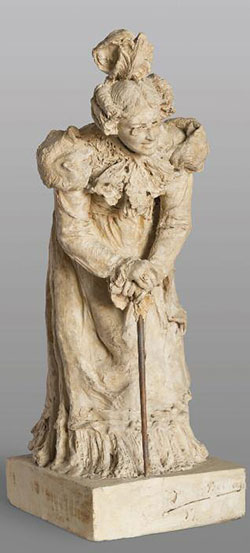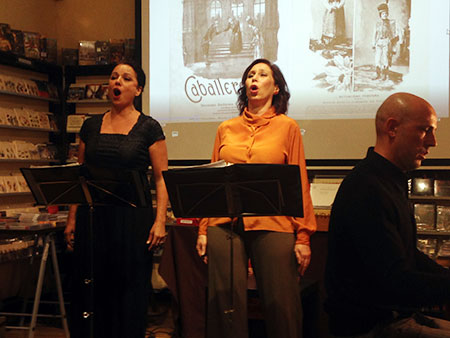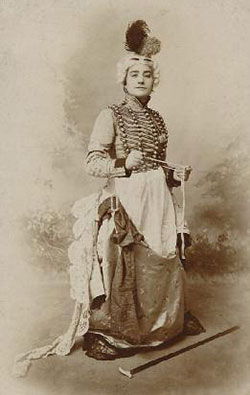|
Anna Tonna |
|
Leading mezzo soprano Anna Tonna
delves into the repertoire of Lucrecia Arana,
the great “tiple-contralto”
from the Golden Age of Zarzuela
As I was investigating repertoire for a concert at the Auditorio Nacional de España for my Madrid based vocal ensemble Líricas del Mundo (with soprano Gloria Londoño and pianist Elías Romero), I became curious about the provenance of the duet composed by Manuel Fernández Caballero for the zarzuela La viejecita (1897).The concert was entitled Amor en travesti, which began with Handel and ended with this very same zarzuela duet, in a program highlighting the tradition of the “trouser role” mezzo soprano in both opera and operetta. The number from La viejecita begins with a plot scene, followed by a love duet written in grand waltz triple time, straight out of Parisian opéra comique.
 I was curious about the singer who created the role of Carlos, the trouser role and romantic “male lead” of La viejecita. I spied a wonderful photo of the tiple contralto Lucrecia Arana in an officer’s costume, sporting a high hat with plumes. The internet led me to the Mariano Benlliure Foundation website: I found that Arana was married to the great Spanish sculptor, with whose works I was familiar through the Hispanic Society of America Museum & Library. I began to correspond with the Foundation’s Director, Lucrecia Enseñat Benlliure, who is the great granddaughter of Benlliure and the great zarzuela diva of the Spanish Golden Age. The foundation was preparing to celebrate the150th anniversary of Arana’s birth in concerts, lectures and exhibitions.
I was curious about the singer who created the role of Carlos, the trouser role and romantic “male lead” of La viejecita. I spied a wonderful photo of the tiple contralto Lucrecia Arana in an officer’s costume, sporting a high hat with plumes. The internet led me to the Mariano Benlliure Foundation website: I found that Arana was married to the great Spanish sculptor, with whose works I was familiar through the Hispanic Society of America Museum & Library. I began to correspond with the Foundation’s Director, Lucrecia Enseñat Benlliure, who is the great granddaughter of Benlliure and the great zarzuela diva of the Spanish Golden Age. The foundation was preparing to celebrate the150th anniversary of Arana’s birth in concerts, lectures and exhibitions.
 Líricas del Mundo was asked by the Mariano Benlliure Foundation to program a concert taking place during May 2017 in Madrid, of Arana’s best-known zarzuela roles, as well as forgotten romanzas and duets from her vast repertoire. We worked closely with the Foundation’s researcher Francisco Javier Osés Sola and received many scores. It became very clear from the beginning that Ms. Arana covered an extremely broad vocal tessitura which defied modern day vocal categories of mezzo and soprano. We examined pieces that were for a mezzo soprano with a good upper extension (La viejecita by Caballero, La cariñosa by Bretón) and for Wagnerian soprano (Los amantes de Teruel by Bretón), as well as romanzas and duets that called for a full lyric soprano (El cabo primero by Chapí, Gigantes y Cabezudos and Dúo de la Africana by Caballero). We encountered many numbers that are now unsung rarities, even in Spain. Knowing that the tuning of the time was somewhat lower (steel strings was not used for the violin, and Spain shifted to a higher tuning standard during the early 1940s), I learned that the history of zarzuela singing revolves around actors that are called upon to sing, and not the other way round – the mirror image of the assiduous vocal training that exists in opera, where theatrical acting is an added layer.
Líricas del Mundo was asked by the Mariano Benlliure Foundation to program a concert taking place during May 2017 in Madrid, of Arana’s best-known zarzuela roles, as well as forgotten romanzas and duets from her vast repertoire. We worked closely with the Foundation’s researcher Francisco Javier Osés Sola and received many scores. It became very clear from the beginning that Ms. Arana covered an extremely broad vocal tessitura which defied modern day vocal categories of mezzo and soprano. We examined pieces that were for a mezzo soprano with a good upper extension (La viejecita by Caballero, La cariñosa by Bretón) and for Wagnerian soprano (Los amantes de Teruel by Bretón), as well as romanzas and duets that called for a full lyric soprano (El cabo primero by Chapí, Gigantes y Cabezudos and Dúo de la Africana by Caballero). We encountered many numbers that are now unsung rarities, even in Spain. Knowing that the tuning of the time was somewhat lower (steel strings was not used for the violin, and Spain shifted to a higher tuning standard during the early 1940s), I learned that the history of zarzuela singing revolves around actors that are called upon to sing, and not the other way round – the mirror image of the assiduous vocal training that exists in opera, where theatrical acting is an added layer.
 We performers had to come to terms with the curious vocal range of the female zarzuela singer in the late 19th century, who was known commonly as the tiple – a ‘jack of all trades’ female voice. The music we had in our hands brought into play the prevalent verismo aesthetic of the late 19th and early 20th century European opera, which showcased a soprano voice blending forcefully the head and chest voice, requiring less of the high tessituras of a coloratura soprano. The result is a vocal production that can cope with heavy orchestration. Having both a soprano and a mezzo to exhibit in tandem the true vocal range of Arana, was clearly the best way to present the complete picture of her repertoire. Although this was the prevalent vocal aesthetic, we also had to sing in Italian bel canto style, reminiscent of Donizetti.
We performers had to come to terms with the curious vocal range of the female zarzuela singer in the late 19th century, who was known commonly as the tiple – a ‘jack of all trades’ female voice. The music we had in our hands brought into play the prevalent verismo aesthetic of the late 19th and early 20th century European opera, which showcased a soprano voice blending forcefully the head and chest voice, requiring less of the high tessituras of a coloratura soprano. The result is a vocal production that can cope with heavy orchestration. Having both a soprano and a mezzo to exhibit in tandem the true vocal range of Arana, was clearly the best way to present the complete picture of her repertoire. Although this was the prevalent vocal aesthetic, we also had to sing in Italian bel canto style, reminiscent of Donizetti.
In my opinion, Arana dealt with the dramatic changes of tessituras by shifting vocal weight and color – very much like contemporary Italian female singers, who were dealing with a similar mixture of theatrical music, from Rossini’s Il barbiere di Siviglia to Saint-Saëns’ Samson et Delilah. I would cite the recordings of the Italian contralto/dramatic mezzo soprano Ebe Stignani, who managed this same feat, one generation after Arana’s.

We also discovered unknown gems such as Miguel Taboada’s El diablo en el Molino, in which Arana played the role of a young man who in order to scare away his rival and win the hand of his beloved, dresses up as the devil. The trova and dúo from this zarzuela were composed in Italian bel canto style and surprised the audience by their lyric beauty. The romanza from La cariñosa by Tomás Bretón is a through-composed, operatic-style aria that goes beyond bel canto into a late romantic style, in which elements from Spanish folklore (such as rhythms derived from the Asturian pandereta, with its 3/3 and 2/3 combinations) are fused into a sophisticated, pan-European sound that could easily grace any music theatre stage in the world. Bretón never ceases to amaze with his inspired compositional technique, in music of the highest quality. Both these roles are firmly in the operatic mezzo soprano range, with strong middle registers and soprano extension.

It was difficult to reconcile these with a singer who also premiered the difficult romanza ‘Yo quiero un hombre’ from El cabo primero, which has been sung by Ángeles Chamorro and Montserrat Caballé in modern times. This Caballero piece suits a big lyric soprano voice commanding agility. It begins treacherously in the lower voice, quickly ascending and descending, and there is a difficult coloratura passage near the end which reminds one of Mozart’s “Come scoglio”! Gloria Londoño is an experienced Fiordiligi, and coped with it marvelously. Other romanzas that were firmly in the soprano territory interpreted by Londoño were Catalina’s from Los diamantes de la corona, Antonelli’s from El dúo de La africana and Pilar’s ‘letter song’ from Gigantes y Cabezudos.
 There is no doubt that Carlos in La viejecita – composed especially for the voice of Arana – is for a mezzo soprano or contralto. Yet although the role lies low, it still needs to shine through Caballero’s heavy orchestration; and in that final duet which triggered our quest, Carlos ascends above the stave in unison with the soprano, to create the musical apex of the entire zarzuela. We also programmed the concert song for voice and piano La Riojanica, a difficult jota which exploited Arana’s range, as well as showcasing her variety of vocal colors in a girl/boy dialogue. The frontispiece of the sheet music has an engraving of Arana and carries a dedication to her from Caballero himself.
There is no doubt that Carlos in La viejecita – composed especially for the voice of Arana – is for a mezzo soprano or contralto. Yet although the role lies low, it still needs to shine through Caballero’s heavy orchestration; and in that final duet which triggered our quest, Carlos ascends above the stave in unison with the soprano, to create the musical apex of the entire zarzuela. We also programmed the concert song for voice and piano La Riojanica, a difficult jota which exploited Arana’s range, as well as showcasing her variety of vocal colors in a girl/boy dialogue. The frontispiece of the sheet music has an engraving of Arana and carries a dedication to her from Caballero himself.
 The concert also highlighted the contemporary appetite for operetta repertoire from countries outside Spain, such as the lovely duet (sung in Spanish translation) from Franz von Suppé’s Boccaccio.
The concert also highlighted the contemporary appetite for operetta repertoire from countries outside Spain, such as the lovely duet (sung in Spanish translation) from Franz von Suppé’s Boccaccio.
For a singer, it was like going through a zarzuela time capsule! Our ‘Arana Quest’ was an unforgettable experience for all of us, as well as affording a bird’s eye view of the unknown treasures that zarzuela holds for anyone willing to scratch beneath the surface of the seemingly endless talent of Spain’s late 19th century composers and lyricists.
© Anna Tonna and zarzuela.net 2018
Art Photos © Fundación Mariano Benlliure
![]() Lucrecia Arana - Book review (Christopher Webber)
Lucrecia Arana - Book review (Christopher Webber)
![]() YouTube video - concert trailer
YouTube video - concert trailer
![]() Fundación Mariano Benlliure
Fundación Mariano Benlliure![]() zarzuela.net
zarzuela.net
7/II/2018
